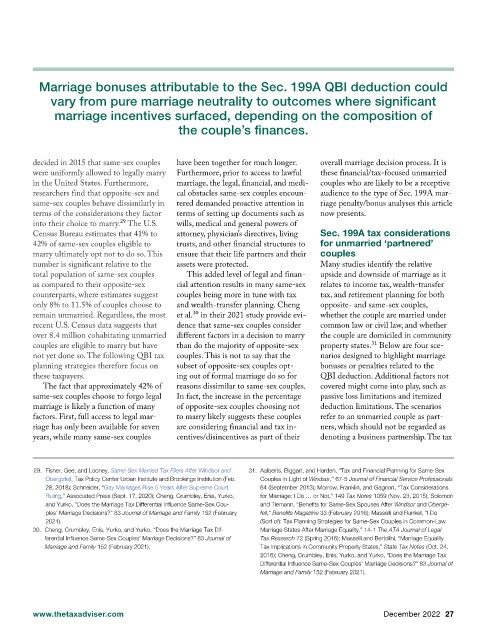Page 636 - TaxAdviser_2022
P. 636
Marriage bonuses attributable to the Sec. 199A QBI deduction could
vary from pure marriage neutrality to outcomes where significant
marriage incentives surfaced, depending on the composition of
the couple’s finances.
decided in 2015 that same-sex couples have been together for much longer. overall marriage decision process. It is
were uniformly allowed to legally marry Furthermore, prior to access to lawful these financial/tax-focused unmarried
in the United States. Furthermore, marriage, the legal, financial, and medi- couples who are likely to be a receptive
researchers find that opposite-sex and cal obstacles same-sex couples encoun- audience to the type of Sec. 199A mar-
same-sex couples behave dissimilarly in tered demanded proactive attention in riage penalty/bonus analyses this article
terms of the considerations they factor terms of setting up documents such as now presents.
into their choice to marry.²⁹ The U.S. wills, medical and general powers of
Census Bureau estimates that 41% to attorney, physician’s directives, living Sec. 199A tax considerations
42% of same-sex couples eligible to trusts, and other financial structures to for unmarried ‘partnered’
marry ultimately opt not to do so. This ensure that their life partners and their couples
number is significant relative to the assets were protected. Many studies identify the relative
total population of same-sex couples This added level of legal and finan- upside and downside of marriage as it
as compared to their opposite-sex cial attention results in many same-sex relates to income tax, wealth-transfer
counterparts, where estimates suggest couples being more in tune with tax tax, and retirement planning for both
only 8% to 11.5% of couples choose to and wealth-transfer planning. Cheng opposite- and same-sex couples,
remain unmarried. Regardless, the most et al.³⁰ in their 2021 study provide evi- whether the couple are married under
recent U.S. Census data suggests that dence that same-sex couples consider common law or civil law, and whether
over 8.4 million cohabitating unmarried different factors in a decision to marry the couple are domiciled in community
couples are eligible to marry but have than do the majority of opposite-sex property states.³¹ Below are four sce-
not yet done so. The following QBI tax couples. This is not to say that the narios designed to highlight marriage
planning strategies therefore focus on subset of opposite-sex couples opt- bonuses or penalties related to the
these taxpayers. ing out of formal marriage do so for QBI deduction. Additional factors not
The fact that approximately 42% of reasons dissimilar to same-sex couples. covered might come into play, such as
same-sex couples choose to forgo legal In fact, the increase in the percentage passive loss limitations and itemized
marriage is likely a function of many of opposite-sex couples choosing not deduction limitations. The scenarios
factors. First, full access to legal mar- to marry likely suggests these couples refer to an unmarried couple as part-
riage has only been available for seven are considering financial and tax in- ners, which should not be regarded as
years, while many same-sex couples centives/disincentives as part of their denoting a business partnership. The tax
29. Fisher, Gee, and Looney, Same-Sex Married Tax Filers After Windsor and 31. Aalberts, Biggart, and Harden, “Tax and Financial Planning for Same-Sex
Obergefell, Tax Policy Center Urban Institute and Brookings Institution (Feb. Couples in Light of Windsor,” 67-5 Journal of Financial Service Professionals
28, 2018); Schneider, “Gay Marriages Rise 5 Years After Supreme Court 64 (September 2013); Morrow, Franklin, and Gagnon, “Tax Considerations
Ruling,” Associated Press (Sept. 17, 2020); Cheng, Crumbley, Enis, Yurko, for Marriage: I Do … or Not,” 149 Tax Notes 1059 (Nov. 23, 2015); Solomon
and Yurko, “Does the Marriage Tax Differential Influence Same-Sex Cou- and Tiemann, “Benefits for Same-Sex Spouses After Windsor and Oberge-
ples’ Marriage Decisions?” 83 Journal of Marriage and Family 152 (February fell,” Benefits Magazine 33 (February 2016); Masselli and Runkel, “I Do
2021). (Sort of): Tax Planning Strategies for Same-Sex Couples in Common-Law
30. Cheng, Crumbley, Enis, Yurko, and Yurko, “Does the Marriage Tax Dif- Marriage States After Marriage Equality,” 14-1 The ATA Journal of Legal
ferential Influence Same-Sex Couples’ Marriage Decisions?” 83 Journal of Tax Research 72 (Spring 2016); Masselli and Bertolini, “Marriage Equality
Marriage and Family 152 (February 2021). Tax Implications in Community Property States,” State Tax Notes (Oct. 24,
2016); Cheng, Crumbley, Enis, Yurko, and Yurko, “Does the Marriage Tax
Differential Influence Same-Sex Couples’ Marriage Decisions?” 83 Journal of
Marriage and Family 152 (February 2021).
www.thetaxadviser.com December 2022 27

